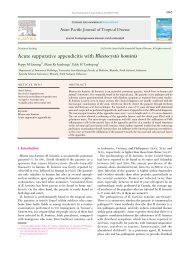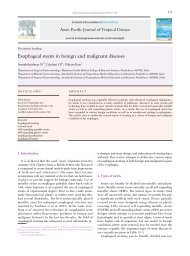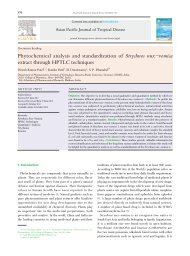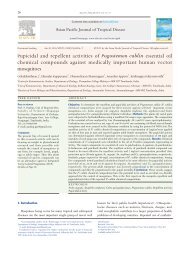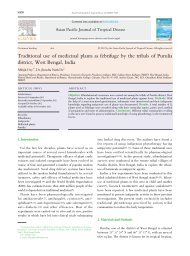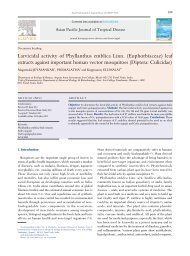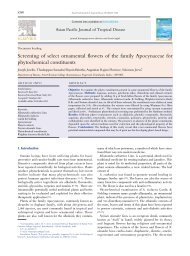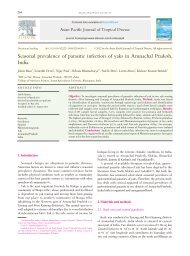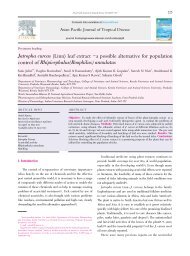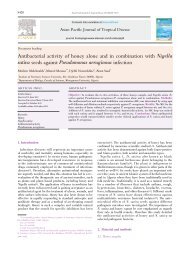Antibacterial activities of some Indian traditional plant extracts
Antibacterial activities of some Indian traditional plant extracts
Antibacterial activities of some Indian traditional plant extracts
Create successful ePaper yourself
Turn your PDF publications into a flip-book with our unique Google optimized e-Paper software.
<strong>of</strong> <strong>plant</strong> <strong>extracts</strong>, antibiotics-cipr<strong>of</strong>loxacin or solvent control.<br />
Finally the MHB medium with overnight test organism (10-8cfu<br />
/ml-1) was equally distributed. All the samples were prepared<br />
in triplicates and incubated at 37 曟for 24 hrs [26].<br />
To determine the MBC, the treated broth culture from well<br />
which is not showing any visible growth in MIC assay was<br />
cultured on new sterile MHA plates. The least concentration<br />
(highest dilution) <strong>of</strong> the extract that inhibits colony formation<br />
on a solid agar medium after incubation at 37 曟 for 24 hr was<br />
considered as MBC [22]<br />
3. Results<br />
The <strong>extracts</strong> <strong>of</strong> Ocimum sanctum, Ocimum gratissimum,<br />
Aegle marmelos and Adhatoda vasica, tested for antibacterial<br />
activity on five human pathogens were presented in Table 1.<br />
The zone <strong>of</strong> inhibition around the disc impregnated with <strong>plant</strong><br />
extract over the lawn <strong>of</strong> bacterial culture plates determined the<br />
antibacterial activity as quantitatively. The result showed that<br />
the antibacterial <strong>activities</strong> <strong>of</strong> <strong>plant</strong> extract were increased with<br />
increasing concentration <strong>of</strong> crude <strong>extracts</strong>. Though the <strong>extracts</strong><br />
showed prominent antibacterial activity against gram negative<br />
(S. typhi, S. paratyphi, E. coli ) and gram positive (S. aureus)<br />
bacteria, only the Klebsiella sp appeared to be resistance with<br />
very less zone <strong>of</strong> inhibition. Among the tested <strong>plant</strong> <strong>extracts</strong><br />
Ocimum gratissimum methonalic extract showed highest<br />
activity <strong>of</strong> 30 mm (0.4g/ml) inhibition zone against S. typhi and<br />
N Prasannabalaji et al./Asian Pacific Journal <strong>of</strong> Tropical Disease (2012)S291-S295 S293<br />
Table 1<br />
<strong>Antibacterial</strong> activity <strong>of</strong> different <strong>plant</strong> extract by disc diffusion method R= no zone <strong>of</strong> inhibition<br />
followed by methanol extract <strong>of</strong> Ocimum sanctum showed 25.5<br />
mm (0.4g/ml) inhibition zone against S. typhi (Table.1). The<br />
Ocimum gratissimum methanol extract also showed maximum<br />
inhibition zone <strong>of</strong> 28 mm (0.4 g/ml) against Salmonella<br />
paratyphi.<br />
On the other hand, the E. coli strain were mostly resistance<br />
to various solvents <strong>of</strong> Adhatoda vasica <strong>plant</strong> extract<br />
and moderately resistant to Ocimum sanctum, Ocimum<br />
gratissimum, while Aegle marmelos methanol extract<br />
demonstrated significant inhibitory activity <strong>of</strong> 22.5mm (0.4 g/<br />
ml) against E. coli strain tested. Also the S. aureus moderately<br />
sensitive to various solvent <strong>extracts</strong> <strong>of</strong> Ocimum sanctum, A.<br />
marmelos, Adhatoda vasica and showed maximum sensitivity<br />
to methanol extract <strong>of</strong> Ocimum gratissimum inhibition with 24<br />
mm (0.4g/ml) zone <strong>of</strong> inhibition.<br />
The Klebsiella sp was resistant to the different concentrations<br />
<strong>of</strong> ethanol, acetone <strong>plant</strong> <strong>extracts</strong> <strong>of</strong> Ocimum sanctum, Aegle<br />
marmelos and Adhatoda vasica, while Ocimum gratissimum<br />
methanol extract demonstrated a inhibition zone <strong>of</strong> 9.0 mm<br />
(0.4g/ml) only. The result showed that S. typhi, S. paratyphi and<br />
S. aureus were the most susceptible species to the different<br />
concentrations <strong>of</strong> methanol extract <strong>of</strong> Ocimum gratissimum<br />
and E. coli susceptible to the <strong>extracts</strong> <strong>of</strong> Aegle marmelos.<br />
The MIC analysis <strong>of</strong> <strong>plant</strong> <strong>extracts</strong> showed the optimum<br />
bacteriostatic and bacteriocidal concentration for methanol<br />
crude <strong>extracts</strong> <strong>of</strong> the <strong>plant</strong>s tested. The table 2 depicted the<br />
MIC and MBC <strong>of</strong> all <strong>plant</strong> <strong>extracts</strong> and the zone <strong>of</strong> inhibition<br />
results reflected in MIC. The MIC <strong>of</strong> all the <strong>plant</strong> <strong>extracts</strong><br />
O.sanctum Ethanol extract (mg/mL) O.sanctum Methanol extract (mg/mL) O. sanctum Acetone extract (mg/mL)<br />
Bacterial species 50 100 200 400 50 100 200 400 50 100 200 400<br />
S. aureus 8.2 9.4 10.2 11.4 12.0 13.5 14.0 14.5 8.0 9.0 10.0 10.5<br />
E.coli R R 6.6 7.8 R R 7.0 7.5 R R R 7.2<br />
S.typhi 10.0 11.5 12.0 14.0 15.0 17.5 22.5 25.5 R 7.0 7.6 8.2<br />
S. paratyphi 8.5 9.6 10.5 12.0 14.0 16.0 19.0 21.0 R 6.0 6.5 7.5<br />
Klebsiella sp R R R 7.0 R.0 7.0 7.0 8.0 R R R 7.2<br />
O. Gratissimum - Methonal <strong>extracts</strong> (mg/mL) O. Gratissimum - Methonal <strong>extracts</strong> (mg/mL) O. Gratissimum Acetone extract (mg/mL)<br />
Bacterial species 50 100 200 400 50 100 200 400 50 100 200 400<br />
S. aureus 8.5 9.5 10.5 12.0 14.0 18.0 22 24.0 R 8.0 9.5 10.5<br />
E.coli R R 6.5 7.0 7.0 8.0 8.5 9.0 R R 6.6 7.2<br />
S. typhi 12.2 14.0 15.5 16.7 19.0 24 28.0 30.0 9.0 10.5 12.2 14.1<br />
S. paratyphi 10 11 12.3 14.5 16.0 22.0 25.0 28.0 7.6 8.6 9.2 10.2<br />
Klebsiella sp R R 7 7.5 R 7.3 8.1 9.0 R R 7.6 8.1<br />
A. Marmelos Ethanol extract (mg/mL) A. marmelos extract (mg/mL) A. Marmelos Acetone extract(mg/mL)<br />
Bacterial species 50 100 200 400 50 100 200 400 50 100 200 400<br />
S. aureus R 7.0 8.5 9.6 11.5 12.5 14 15 R 7.0 7.2 8.5<br />
E.coli R 8.0 9.0 10.5 16 17 17.5 22.5 R 7.0 8.0 9.0<br />
S. typhi R 6.9 8.5 10.2 12 14 17 18 R R 8.0 8.6<br />
S. paratyphi R 7.0 7.6 8.2 9.0 10.5 11 11 R R 7.0 7.0<br />
Klebsiella sp R R R 7 R R R 8.5 R R R R<br />
A.vasica Ethanol extract (mg/mL) A. vasica Methanol extract (mg/mL) A.vasica Acetone extract(mg/mL)<br />
Bacterial species 50 100 200 400 50 100 200 400 50 100 200 400<br />
S. aureus R R R 7 R R R 7.2 R R R 6.9<br />
E.coli R 7.0 8.1 8.5 R 8.0 8.0 9.0 R R R 7.2<br />
S. typhi R R R R R R 7.0 7.3 R R R R<br />
S. paratyphi R R R R R R R R R R R R<br />
Klebsiella sp R R R R R R R R R R R R



